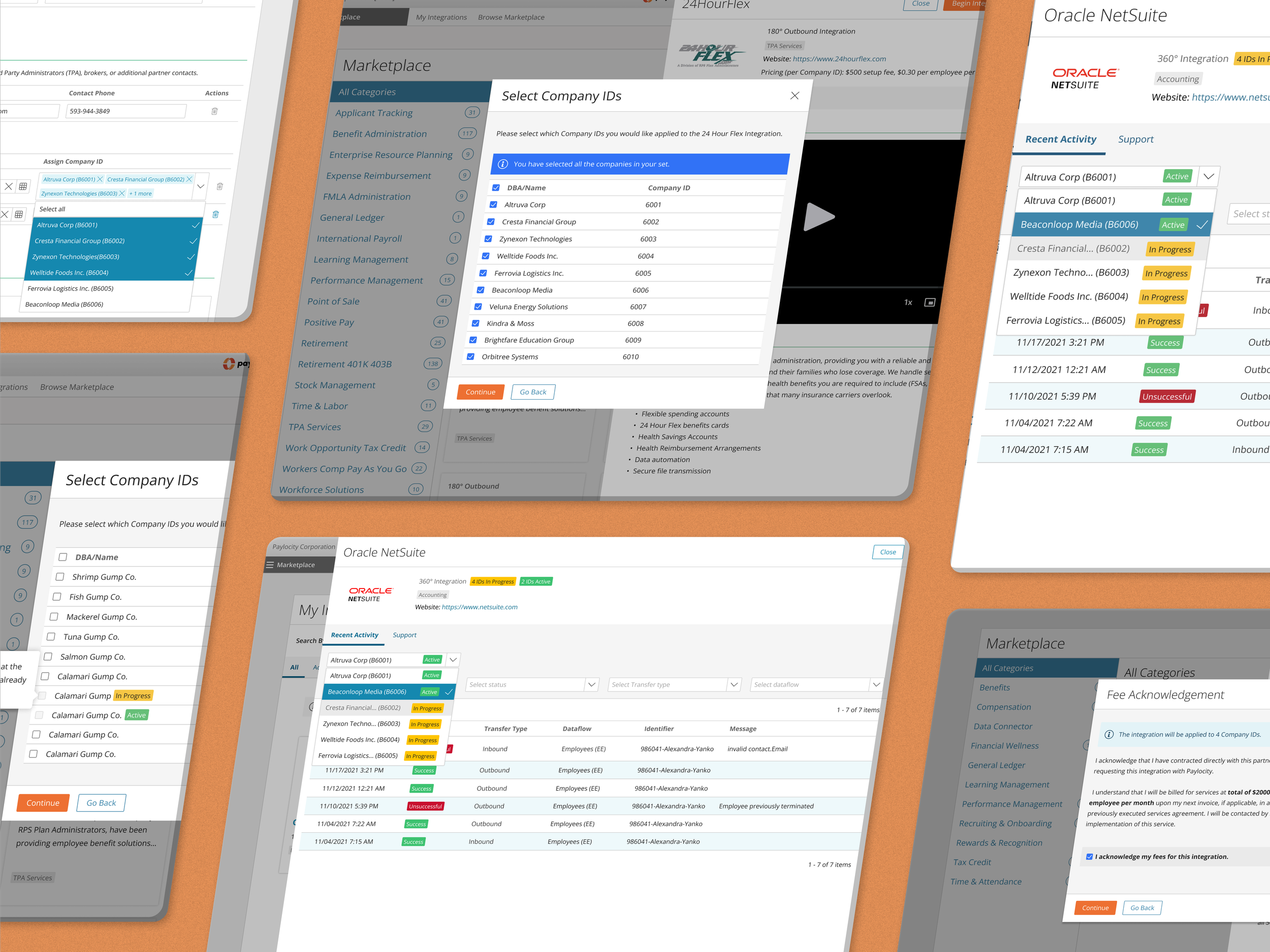Streamlining large-scale integration purchases in the Marketplace
Role
Product Design Lead
Scope
Brand new purchase flow in the Marketplace
About the Project
Paylocity’s Marketplace is an online platform where customers can explore, purchase, and seamlessly connect third-party partner integrations to their systems.
For this project, my goal was to enhance the Marketplace by introducing functionality that enables customers to purchase integrations at scale.
Currently, integrations are discovered, purchased, configured, and invoiced at the individual company level, with no unified Marketplace experience for Company Sets. Company Sets are groups of related companies, and over 75% of our enterprise customers belong to one — making this enhancement a vital step toward better serving their needs.
Business Objectives
Duration
3 months
Team
1 Product Manager
3 Developers
Platform
Desktop
Enhance Client Experience for Company Sets:
Streamline the Marketplace experience by enabling clients to discover, purchase, configure, and manage integrations at the company set level, eliminating the need for repetitive actions at the individual company level.Drive Operational Efficiency:
Reduce the logistical burden on the tech services team by simplifying the configuration and support process for integrations applied across multiple company IDs in a set.Support High-Value Client Relationships:
Cater to the ~30% of clients who are part of company sets — our highest-paying and most strategic customers — by offering a more scalable and efficient Marketplace experience.
Defining the Experience Through Collaborative Discovery
Before diving into flow creation, we took a human-centered approach to understand the needs and behaviors of Company Set Administrators. We began by mapping key interactions and decision points to surface pain points and opportunities for simplification. In partnership with Product, we co-defined the core use cases driving the discovery and purchase experience. This alignment helped ground our design objectives in real user needs. With these insights, we crafted initial user flows to visualize the ideal journey of a Company Admin from the moment they enter the Marketplace to successfully purchasing integrations across multiple child IDs. This allowed us to ensure the path forward was intuitive, scalable, and rooted in empathy.
Purchase User Flow
Integration Management User Flow
Challenges & Iterations
Challenge 1: Uncovering Edge Cases with Company Set Purchases
As we began sharing our designs with EDI specialists and subject matter experts, smaller edge cases started to emerge that we hadn’t initially considered. One notable complexity involved the nuances of company sets—specifically, the ability for users to initiate integration purchases at the single ID level rather than for the entire set. This raised an important design question: how would we indicate to customers purchasing at the company set level that an integration had already been purchased at an individual company ID level? Ensuring clarity here was critical to avoid confusion and duplicate purchases.
How We Addressed This Challenge
We introduced functionality informing customers that will not be able to select IDs to purchase if they are already configured at the single ID level.
Challenge 2: Accounting for Prepaid Integrations in Setup Flows
We also had to address scenarios where customers pre-purchase integrations through their sales contracts with Account Managers. These situations follow what we call the “Ready to Set Up” flow. When a Company Admin logs into Paylocity and sees an integration tile labeled “Ready to Set Up,” it means the setup fee has already been handled, and they are taken straight to the Integration Request Form, bypassing the pricing modal.
While this flow works at the individual ID level, we had to explore what this looked like at the company set level. Questions arose: What happens if a client purchases an integration for a partial company set and wants to add more at a later time? How would we track and communicate which IDs have been set up versus what IDs are still available?
Through multiple iterations, cross-functional collaboration, and by referencing existing Ready to Set Up experiences, we designed a scalable and intuitive solution that works at both the single ID and company set levels.
If an integration is only applied to a few IDs in a set, then users have the option of beginning the integration for the remaining IDs.
If an integration has been applied to the entire Company Set, then users will not have the option of beginning the integration.
Our Final Designs
Results
Since release (4/1/25-today), we've had 114 company set Marketplace completions (85 multi-id purchases and 29 multi-id ready to set up).








